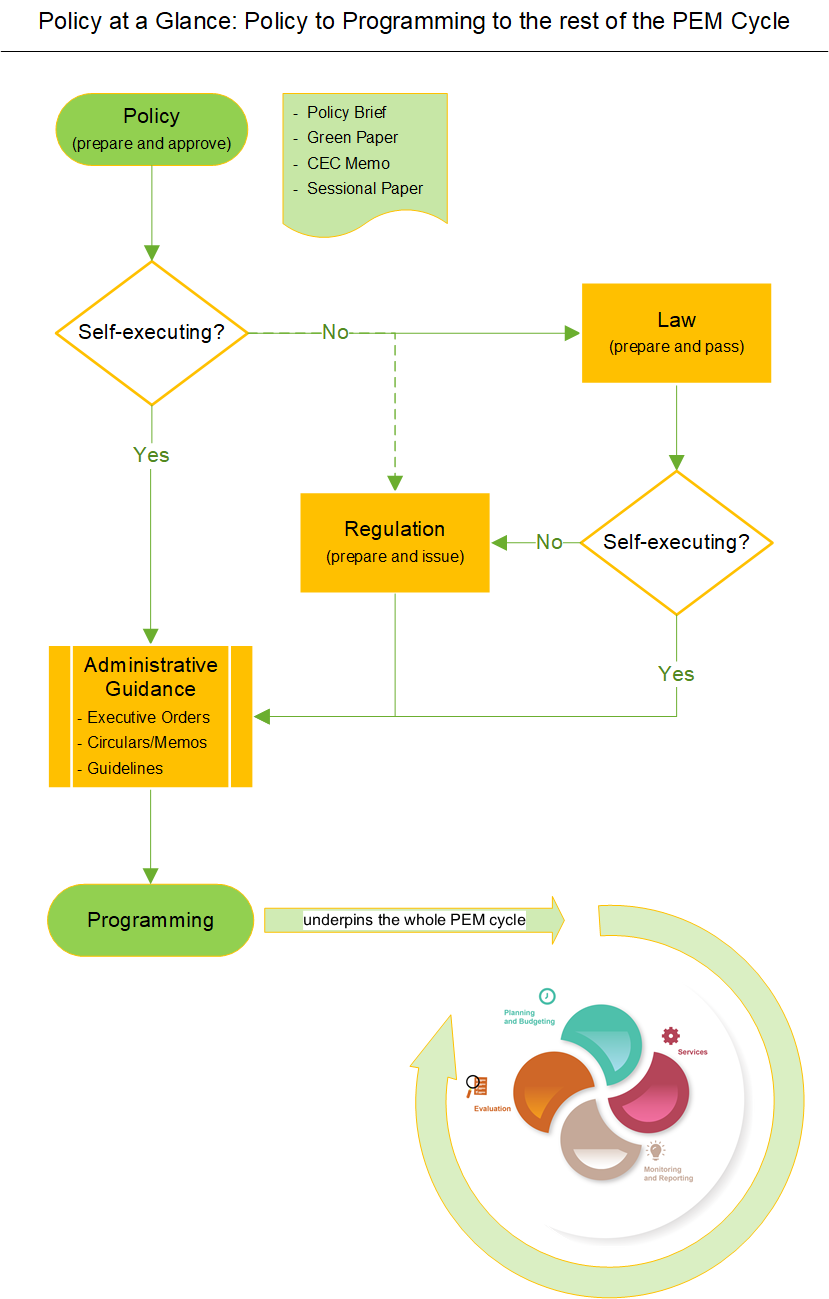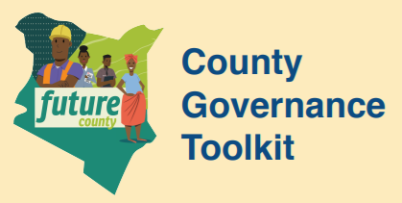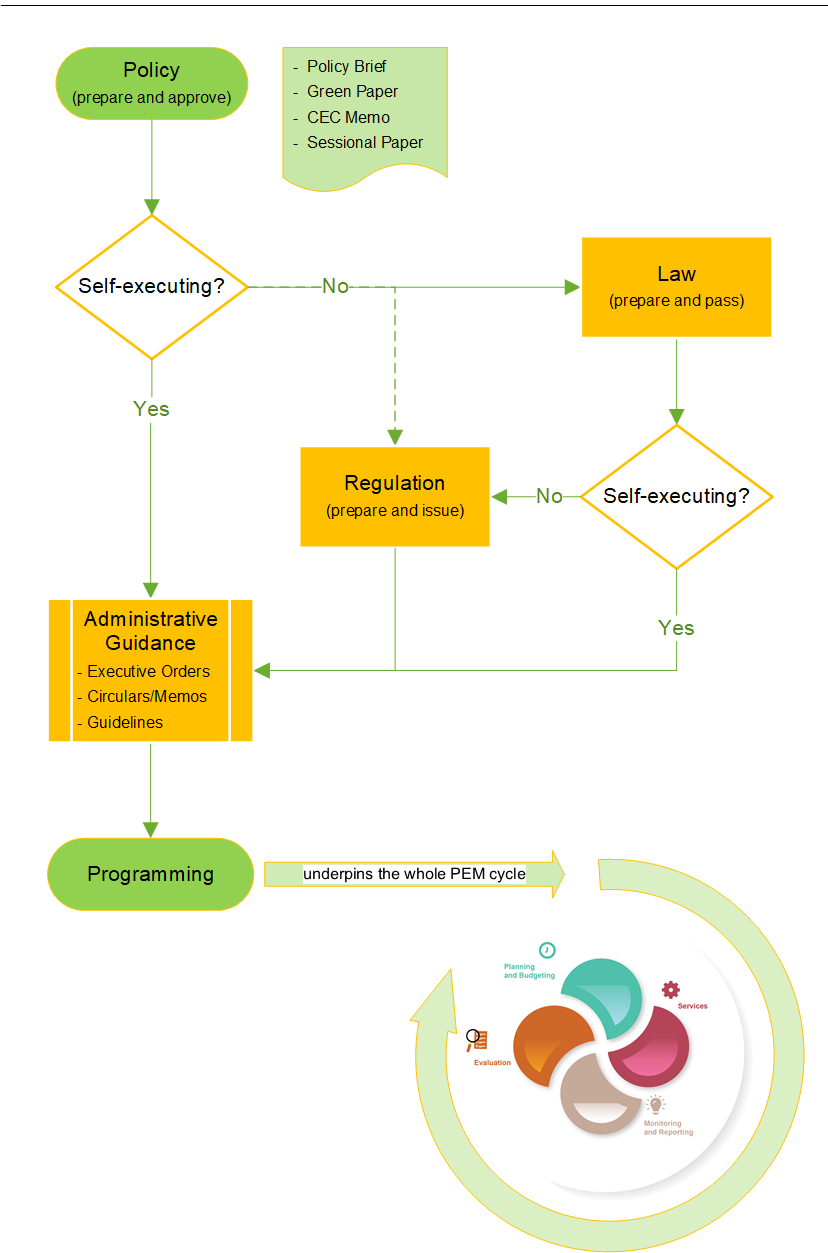Public policies are the general principles by which a government is guided in its management of public affairs. Policy making broadly refers to the process used by a government to decide what to do (or not to do) about a public problem or issue that requires its attention and action.
A public policy is usually needed when a new problem arises – say a new pandemic or locusts – or when as a society we feel the need to try new solutions to pre-existing problems. The name “public” indicates that these policies shape the behavior of the government – a public entity – but also that they have an impact on the lives of all the citizens by changing the way services are provided or by changing laws or regulations. This is why public participation and ownership is critical for the successful design and implementation of government policies.
Policy and the PEM Cycle
Policy is often the “launch pad” of the government decision-making process. Best practice recommends that all laws and regulations should be underpinned by policy. Once developed, a policy may be self-executing or non-self-executing. Self-executing policy is immediately implementable, and only requires administrative action – such as executive orders, circulars and guidelines – in order to translate into programming. A non-self-executing policy requires further development and passage of laws and or regulations to facilitate its implementation through programmes. Follow the flow chart for a visual description of these processes.
For more information on the key public policy processes, see the descriptions and follow the links below.

| 1 |
A statement of long-term sectoral or thematic objectives and measures to address a given issue in the County. Policies take different forms, from Briefs to White Papers and usually follow a defined process for their formulation.
|
| 2 |
More prescriptive than policy in defining the conduct of government and society within a given jurisdiction, it might offer incentives and more often defines sanctions and penalties for breaches of such conduct. Although legislative proposals may originate from different sources, all county laws are made by the County Assembly.
|
| 3 |
Also referred to as “subsidiary legislation”, regulations give practical effect to law by (a) providing the stepwise detail necessary to enforce the law and (b) monitoring such enforcement.
|
| 4 |
This process provides the critical link between policy and the rest of the PEM cycle. Programmes underpin the whole cycle as they are (a) the building blocks of plans and budgets; (b) are designed to achieve the desired policy outcomes and objectives; (c) they combine services delivered through the recurrent and development budget; and (d) are monitored and evaluated to determine if policies need review.
|
The County Executive takes a general lead in policy making, inviting stakeholder and citizen participation at various stages and seeking final approval from the County Assembly. For policies requiring specific laws prior to implementation, the County Executive will work closely with the County Assembly through the process of bill development, bill readings and passage, leading to enactment and gazettement. A similar approach may sometimes be required for regulations (through County Assembly committee on delegated and subsidiary legislation). Finally, the County Executive is responsible for the ultimate transformation of policy into programs through various administrative instruments, including executive orders, circulars, memos and guidelines and through the statutory planning and budgeting process.
The County Assembly plays four vital roles in the policy making process. First, reviewing and approving proposed policy documents tabled by the County Executive. Sector committees are actively involved in this effort. Second, through the passage of laws to give effect to policy. Third, through oversight and approval (as required) of regulations that give effect to policy and law. A final more general role involves ensuring citizen engagement and public participation in decisions that give rise to new policy, as well as law and regulations. All county policies, laws and (where necessary) regulations must be approved by the County Assembly.
The citizen’s role in policy making revolves around the relevant steps of the policy cycle. Citizens should contribute to the agenda-setting or problem-solving agenda that initiates the policy making process. Citizens will actively participate in, and contribute to, the review of options and identification of priority solutions. Finally, citizens should hold their government to account by verifying that these priority solutions are properly reflected in official policy documents prior to their approval. Similar inputs are expected, where possible, in the case where laws and regulations are needed to support such policy.
- Sector Working Groups (SWGs) allow constant interaction between technical departments and sector stakeholders. SWGs are critical in providing the most sound and viable technical options to achieve desired outcomes.
- County Budget and Economic Forum (CBEF) facilitates high-level discussions on the match between county socio-economic priorities and the county government’s various policy frameworks. These high-level discussions are critical in framing county economic policy.
- County Commissioner offices and National Government agencies promote well-functioning, two-way communication, cooperation, coordination and collaboration. This is critical to ensure the complementarity and consistency between national and county policies.

